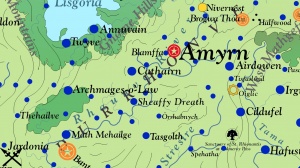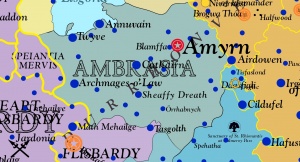Difference between revisions of "Ambrasia"
Trismegistus (talk | contribs) m |
Trismegistus (talk | contribs) |
||
| (9 intermediate revisions by the same user not shown) | |||
| Line 13: | Line 13: | ||
=Language= | =Language= | ||
{{See also|Gonfalese Language|Durrhaunvish Language|Uryalan Language|Ambrasian Language|Classical Yophenthean}} | {{See also|Gonfalese Language|Durrhaunvish Language|Uryalan Language|Ambrasian Language|Classical Yophenthean}} | ||
| − | The language of Ambrasia is the [[Gonfalese Language]]. In ancient times, the [[Durrhaunvish Language]] was spoken in Ambrasia. The Durrhaunvish Language was a member of the [[Moigthe Language Family]] which includes the [[Pytharnian Language|Pytharnian]], [[Dúrandworese Language|Dúrandworese]], [[Erechórebese Language|Erechórebese]], and [[Asbardian Language|Asbardian]] Languages. After the [[Fall of the Yophenthean Empire]], [[Classical Yophenthean]] changed into the [[Ambrasian Language]] which subsequently was displaced by the [[Gonfalese Language]]. Today, the Durrhaunvish Language and Ambrasian Language are extinct and known only to scholars. The language of the [[Uryala Gnomes]] is spoken on the strip of forested land along the shore of [[Lake Lisgoria]]. | + | The language of Ambrasia is the [[Gonfalese Language]]. In ancient times, the [[Durrhaunvish Language]] was spoken in Ambrasia. The Durrhaunvish Language was a member of the [[Moigthe Language Family]] which includes the [[Pytharnian Language|Pytharnian]], [[Dúrandworese Language|Dúrandworese]], [[Erechórebese Language|Erechórebese]], and [[Asbardian Language|Asbardian]] Languages. After the [[Fall of the Yophenthean Empire]], [[Classical Yophenthean]] changed into the [[Ambrasian Language]] which subsequently was displaced by the [[Gonfalese Language]]. Today, the Durrhaunvish Language and Ambrasian Language are extinct and known only to scholars and heliophants. The local language of the [[Uryala Gnomes]] is spoken on the strip of forested land along the shore of [[Lake Lisgoria]]. |
=Gods and Religion= | =Gods and Religion= | ||
| − | The historic, pre-Arathracian cults of the [[Durrhaunve]] included the worship of the sun god (called [[Ari]] by the [[Moigthe]]) since [[Kemerite]] times, centered in [[Amyrn]], the worship of the divinity of the [[Rhaunve River]], the god [[Rhaunfo]], and the [[Durrhaunvian Triad]] or three goddesses, [[ | + | {{See also|Moigthe Gods and Religion|Neptultchi Gods and Religion}} |
| + | The historic, pre-Arathracian cults of the [[Durrhaunve]] included the worship of the sun god (called [[Ari]] by the [[Moigthe]]) since [[Kemerite]] times, centered in [[Amyrn]], the worship of the divinity of the [[Rhaunve River]], the god [[Rhaunfo]], and the [[Durrhaunvian Triad]] or three goddesses, [[Dáunau]], ([[Uki]]), [[Dáwan]], [[Devahlia]], and [[Dasironessa]]. Other important divinities include [[Itlume]] god of the waters under the earth, [[Smidgurt]], a solar war divinity, [[Mamuhan]], the undersea god-smith, and [[Rhion]], god of wine and transformation. [[Ugina]] ([[Dáunau]]) and [[Luvas]] are also of great importance as the parents of the [[Durrhaunvian Triad]]. Chaos divinities, such as [[Gwona]], [[Graäenevoihigh]], and [[Lygdamion]] were worshiped before being stamped out by the [[Arathracian]]s. Other minor divinities include [[Ambrin]], goddess of the hunt and sacred groves, [[Aigchu]], god of pilgrims and wanderers, [[Glambsa]], goddess of the harvest, [[Nagcha]], goddess of the spring harvest, [[Rhaunfo]], [[Rhaunvoig]], a goddess of the [[Rhaunve River]], and [[Shechwbrin]], god of lanterns and lost persons. [[Xankatsul]] and minor divinities surviving from the time of the [[Neptultchi]] continued to be worshiped by peasant farmers. The [[dragonmount riders]] continued to worship [[Neptultchi]] divinities, such as [[Q'aaskicha'a]], the dragonmother. | ||
=Chronology of Ambrasia= | =Chronology of Ambrasia= | ||
| − | * 1100's [[Ambrasian Reformation]] | + | {{Main|Chronology of Ambrasia}} |
| − | * ca 1280 [[Settlement of Gonfaloy]] | + | * 1100's [[Ambrasian Reformation]] begins the religion of [[Ambrasianism]]. |
| + | * ca 1280 [[Settlement of Gonfaloy]], [[Ybawvrach the Sharp]] | ||
=See Also= | =See Also= | ||
Latest revision as of 21:18, 17 November 2024

The country of Ambrasia rests on the upper and middle valley of the Rhaunve Valley in the land historically known as Durrhaunve. The climate is maritime temperate with warm summers and cool winters.

Archpatriarchy of Ambrasia
The Archpatriarchy of Ambrasia honors the king of the Isxinthions, Amrulon. The high priest of Ambrasia resides in a palatial temple in Amyrn, the capital of the realm. The principle language of Ambrasia is Gonfalese which it shares with the Principality of Gonfaloy, Medibgóëse Gonfaloy, the Duchy of Flamander, the Duchy of Ygdafyl, and the March of Amosgire. The Archpatriarchy of Ambrasia rests between Asbardy, Gonfaloy, and the Ithrads.
Ambrasia has resisted invitations to become a principality of the Empire of Magdala nor has she petitioned to join the Union of Pytharnia. Ambrasia enjoys special trade status with the Commonwealth of the Ithrads.
Language
The language of Ambrasia is the Gonfalese Language. In ancient times, the Durrhaunvish Language was spoken in Ambrasia. The Durrhaunvish Language was a member of the Moigthe Language Family which includes the Pytharnian, Dúrandworese, Erechórebese, and Asbardian Languages. After the Fall of the Yophenthean Empire, Classical Yophenthean changed into the Ambrasian Language which subsequently was displaced by the Gonfalese Language. Today, the Durrhaunvish Language and Ambrasian Language are extinct and known only to scholars and heliophants. The local language of the Uryala Gnomes is spoken on the strip of forested land along the shore of Lake Lisgoria.
Gods and Religion
The historic, pre-Arathracian cults of the Durrhaunve included the worship of the sun god (called Ari by the Moigthe) since Kemerite times, centered in Amyrn, the worship of the divinity of the Rhaunve River, the god Rhaunfo, and the Durrhaunvian Triad or three goddesses, Dáunau, (Uki), Dáwan, Devahlia, and Dasironessa. Other important divinities include Itlume god of the waters under the earth, Smidgurt, a solar war divinity, Mamuhan, the undersea god-smith, and Rhion, god of wine and transformation. Ugina (Dáunau) and Luvas are also of great importance as the parents of the Durrhaunvian Triad. Chaos divinities, such as Gwona, Graäenevoihigh, and Lygdamion were worshiped before being stamped out by the Arathracians. Other minor divinities include Ambrin, goddess of the hunt and sacred groves, Aigchu, god of pilgrims and wanderers, Glambsa, goddess of the harvest, Nagcha, goddess of the spring harvest, Rhaunfo, Rhaunvoig, a goddess of the Rhaunve River, and Shechwbrin, god of lanterns and lost persons. Xankatsul and minor divinities surviving from the time of the Neptultchi continued to be worshiped by peasant farmers. The dragonmount riders continued to worship Neptultchi divinities, such as Q'aaskicha'a, the dragonmother.
Chronology of Ambrasia
- 1100's Ambrasian Reformation begins the religion of Ambrasianism.
- ca 1280 Settlement of Gonfaloy, Ybawvrach the Sharp
See Also
- Ambrasian Reformation
- Amrulon
- Amyrn
- Durrhaunve
- Gonfalese Language
- Great Earthquake of Amyrn (2207)
- Pytharnia
| This article is a stub. It requires further development by the creator. |